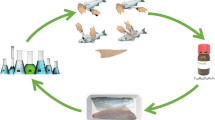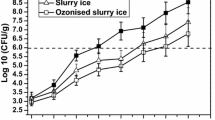Abstract
Antimicrobial activity of essential oils is widely known, but their application to fish preservation is already limited. The objective was to evaluate the microbiological characteristics and quality changes in turbot (Scophthalmus maximus) fillets with essential oil fumigation treatments over 20 days stored at 2 ± 1 °C. The turbot fillets were fumigated with a series of concentrations (1, 4, and 8 μL/L) of essential oils of clove, cumin, and spearmint. Changes in the color, texture profile analysis (TPA), peroxide value (PV), 2-thiobarbituric acid (TBA), total volatile basic nitrogen (TVB-N), trimethylamine nitrogen (TMA-N), microbial characteristics (total viable count, psychrotrophic count, pseudomonads, Shewanella putrefaciens, Enterobacteriaceae, and lactic acid bacteria count) were measured. The results showed the turbot fillets from the control group were the first (day 10) to indicate signs of degradation reaching rejection threshold values for all evaluated parameters. All essential oils could inhibit the oxidation of turbot fillets, and the most effective essential oil was spearmint oil. Fumigated with 4 μL/L spearmint oil maintained the color and texture, retarded the lipid and protein oxidation, and reduced the microorganism counts. Therefore, post-mortem essential oil fumigation treatment has positive effects on improving the quality of refrigerated turbot fillets.


Similar content being viewed by others
References
Alparslan, Y., Baygar, T., Baygar, T., Hasanhocaoglu, H., & Metin, C. (2014). Effects of gelatin-based edible films enriched with laurel essential oil on the quality of rainbow trout (Oncorhynchus mykiss) fillets during refrigerated storage. Food Technology and Biotechnology, 52, 325–333.
AOAC. (2005). Official methods of analysis (18th ed.). Arlington: Association of Official Analytical Chemists.
Attouchi, M., & Sadok, S. (2012). The effects of essential oils addition on the quality of wild and farmed sea bream (Sparus aurata) stored in ice. Food and Bioprocess Technology, 5, 1803–1816.
Aubourg, S. P., Piñeiro, C., Gallardo, J. M., & Barros-Velazquez, J. (2005). Biochemical changes and quality loss during chilled storage of farmed turbot (Psetta maxima). Food Chemistry, 90, 445–452.
Bahmani, Z. A., Rezai, M., Hosseini, S. V., Regenstein, J. M., Bohme, K., Alishahi, A., et al. (2011). Chilled storage of golden gray mullet (Liza aurata). LWT--Food Science and Technology, 44, 1894–1900.
Bensid, A., Ucar, Y., Bendeddouche, B., & Ozogul, F. (2014). Effect of the icing with thyme, oregano and clove extracts on quality parameters of gutted and beheaded anchovy (Engraulis encrasicholus) during chilled storage. Food Chemistry, 145, 681–686.
Botsoglou, N. A., Fletouris, D. J., Papageorgiou, G. E., Vassilopoulos, V. N., Mantis, A. J., & Trakatellis, A. G. (1994). Rapid, sensitive and specific thiobarbituric acid method for measuring peroxidation in animal tissue, food and feedstuff samples. Journal of Agricultural and Food Chemistry, 42, 1931–1937.
Bourne, M. C. (2002). Concept and measurement. In Food texture and viscosity (2nd ed). New York: Academic Press.
Burt, S. (2004). Essential oils: their antibacterial properties and potential applications in food—a review. International Journal of Food Microbiology, 94, 223–253.
Cai, L. Y., Wu, X. S., Dong, Z. J., Li, X. P., Yi, S. M., & Li, J. R. (2014). Physicochemical responses and quality changes of red sea bream (Pagrosomus major) to gum arabic coating enriched with ergothioneine treatment during refrigerated storage. Food Chemistry, 160, 82–89.
Cerisuelo, J. P., Bermudez, J. M., Aucejo, S., Catala, R., Gavara, R., & Hernandez-Munoz, P. (2013). Describing and modeling the release of an antimicrobial agent from an active PP/EVOH/PP package for salmon. Journal of Food Engineering, 116, 352–361.
Coban, O. E. (2013). Evaluation of essential oils as a glazing material for frozen rainbow trout (Oncorhynchus mykiss) fillet. Journal of Food Processing and Preservation, 37, 759–765.
Daniel, A. P., Veeck, A. P. L., Klein, B., Ferreira, L. F., da Cunha, M. A., Parodi, T. V., et al. (2014). Using the essential oil of Aloysia triphylla (L'Her.) britton to sedate silver catfish (Rhamdia quelen) during transport improved the chemical and sensory qualities of the fish during storage in ice. Journal of Food Science, 79, S1205–S1211.
El-Marrakchi, A., Bennour, B., Bouchriti, N., Hamama, A., & Tagafait, H. (1990). Sensory, chemical, and microbiological assessments of Moroccan sardines (Sardina pilchardus) stored in ice. Journal of Food Protection, 53, 600–605.
Feng, L. F., Jiang, T. J., Wang, Y. B., & Li, J. R. (2012). Effects of tea polyphenol coating combined with ozone water washing on the storage quality of black sea bream (Sparus macrocephalus). Food Chemistry, 135, 2915–2921.
Gao, M. S., Feng, L. F., & Jiang, T. J. (2014). Browning inhibition and quality preservation of button mushroom (Agaricus bisporus) by essential oils fumigation treatment. Food Chemistry, 149, 107–113.
Gines, R., Valdimarsdottir, T., Sveinsdottir, K., & Thorarensen, H. (2004). Effects of rearing temperature and strain on sensory characteristics, texture, colour and fat of Arctic charr (Salvelinus alpinus). Food Quality and Preference, 15, 177–185.
Golas, A. E., & Kontominas, M. G. (2007). Combined effect of light salting, modified atmosphere packaging and oregano essential oil on the shelf-life of sea bream (Sparus aurata): biochemical and sensory attributes. Food Chemistry, 100, 287–296.
Gomez-Estaca, J., de Lacey, A. L., Lopez-Caballero, M. E., Gomez-Guillen, M. C., & Montero, P. (2010). Biodegradable gelatin-chitosan films incorporated with essential oils as antimicrobial agents for fish preservation. Food Microbiology, 27, 889–896.
Harpaz, S., Glatman, L., Drabkin, V., & Gelman, A. (2003). Effects of herbal essential oils used to extend the shelf life of fresh water reared Asian sea bass fish (Lates calcarifer). Journal of Food Protection, 66, 410–417.
Imsland, A. K., & Jonassen, T. M. (2001). Regulation of growth in turbot (Scophthalmus maximus Rafinesque) and Atlantic halibut (Hippoglossus hippoglossus L.): aspects of environment × genotype interactions. Reviews in Fish Biology and Fisheries, 11, 71–90.
International Commission on Microbiological Specifications for Foods (ICMSF). (1986). Sampling plans for fish and shellfish, ICMSF, Microorganisms in Foods, second ed. Sampling for microbiological analysis: principles and scientific applications, vol. 2 (pp. 181–196). Toronto: University of Toronto Press.
Jouki, M., Yazdi, F. T., Mortazavi, S. A., Koocheki, A., & Khazaei, N. (2014). Effect of quince seed mucilage edible films incorporated with oregano or thyme essential oil on shelf life extension of refrigerated rainbow trout fillets. International Journal of Food Microbiology, 174, 88–97.
Kedia, A., Prakash, B., Mishra, P. K., Chanotiya, C. S., & Dubey, N. K. (2014). Antifungal, antiaflatoxigenic, and insecticidal efficacy of spearmint (Mentha spicata L.) essential oil. International Biodeterioration & Biodegradation, 89, 29–36.
Mahmoud, B. S. M., Yamazaki, K., Miyashita, K., Shin, I. S., Chang, D. S., & Suzuki, T. (2004). Bacterial microflora of carp (Cyprinus carpio) and its shelf-life extension by essential oil compounds. Food Microbiology, 21, 657–666.
Nuin, M., Alfaro, B., Cruz, Z., Argarate, N., George, S., Le Marc, Y., Olley, J., & Pin, C. (2008). Modelling spoilage of fresh turbot and evaluation of a time—temperature integrator (TTI) label under fluctuating temperature. International Journal of Food Microbiology, 127(3), 193–199.
Ojagh, S. M., Rezaei, M., Razavi, S. H., & Hosseini, S. M. H. (2010). Development and evaluation of a novel biodegradable film made from chitosan and cinnamon essential oil with low affinity toward water. Food Chemistry, 122, 161–166.
Orban, E., Nevigato, T., Di Lena, G., Masci, M., Casini, I., Caproni, R., & Rampacci, M. (2011). Total volatile basic nitrogen and trimethylamine nitrogen levels during ice stoage of European hake (Merluccius merluccius): a seasonal and size differentiation. Food Chemistry, 128, 679–682.
Ozogul, Y., & Balikci, E. (2013). Effect of various processing methods on quality of mackerel (Scomber scombrus). Food and Bioprocess Technology, 6, 1091–1098.
Palou, E., Lopez-Malo, A., Barbosa-Canovas, G. V., Welti-Chanes, J., & Swanson, G. B. (1999). Polyphenoloxidase activity and colour of blanched and high hydrostatic pressure treated banana puree. Journal of Food Science, 64, 42–45.
Pyrgotou, N., Giatrakou, V., Ntzimani, A., & Savvaidis, I. N. (2010). Quality assessment of salted, modified atmosphere packaged rainbow trout under treatment with oregano essential oil. Journal of Food Science, 75, M406–M411.
Ross, C. F., & Smith, D. M. (2006). Use of volatiles as indicators of lipid oxidation in muscle foods. Comprehensive Reviews in Food Science and Food Safety, 5, 18–25.
Santos, J., Lisboa, F., Pestana, N., Casal, S., Alves, M. R., & Oliveira, M. B. P. P. (2013). Shelf life assessment of modified atmosphere packaged turbot (Psetta maxima) fillets: evaluation of microbial, physical and chemical quality parameters. Food and Bioprocess Technology, 6, 2630–2639.
Serdaroglu, M., & Felekoglu, E. (2005). Effects of using rosemary extract and onion juice on oxidative stability of sardine (Sardina pilchardus) mince. Journal of Food Quality, 28, 109–120.
Sowbhagya, H. B. (2013). Chemistry, technology, and nutraceutical functions of cumin (Cuminum cyminum L): an overview. Critical Reviews in Food Science and Nutrition, 53, 1–10.
Taheri, S., Motallebi, A., Fazlara, A., & Aghababyan, A. (2013). Effect of Zataria multiflora Boiss (Avishan shirazi) essential oil on oxidative progress in frozen cobia fish fillets during storage. Journal of Aquatic Food Product Technology, 22, 310–321.
USFDA, U.S. Food and Drug Administration (2006). Food additive status list. http://www.cfsan.fda.gov/%3Ddms/opa-appa.html#ftn.H. Accessed 20 Jul 2009.
Acknowledgment
This study was supported by the National Natural Science Foundation of China (31401478, 31471639, 31301572), the National Key Technologies R&D Program of China during the 12th Five-Year Plan Period (2012BAD29B06) and the Food Safety Key Laboratory of Liaoning Province (LNSAKF2013011).
Author information
Authors and Affiliations
Corresponding author
Additional information
Luyun Cai and Ailing Cao contributed equally to this work.
Rights and permissions
About this article
Cite this article
Cai, L., Cao, A., Li, T. et al. Effect of the Fumigating with Essential Oils on the Microbiological Characteristics and Quality Changes of Refrigerated Turbot (Scophthalmus maximus) Fillets. Food Bioprocess Technol 8, 844–853 (2015). https://doi.org/10.1007/s11947-014-1453-0
Received:
Accepted:
Published:
Issue Date:
DOI: https://doi.org/10.1007/s11947-014-1453-0




